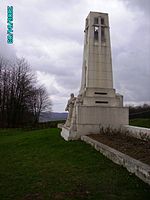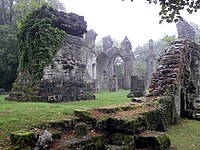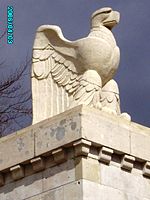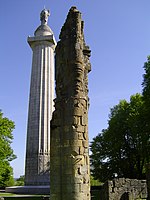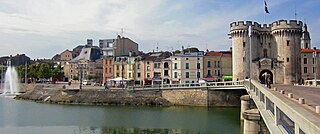
Verdun is a large city in the Meuse department in Grand Est, northeastern France. It is an arrondissement of the department.

The Meuse–Argonne offensive was a major part of the final Allied offensive of World War I that stretched along the entire Western Front. It was fought from September 26, 1918, until the Armistice of November 11, 1918, a total of 47 days. The Meuse–Argonne offensive was the largest in United States military history, involving 1.2 million American soldiers. It is also the deadliest battle in the history of the United States Army, resulting in over 350,000 casualties, including 28,000 German lives, 26,277 American lives and an unknown number of French lives. American losses were worsened by the inexperience of many of the troops, the tactics used during the early phases of the operation and the widespread onset of the global influenza outbreak called the "Spanish flu".

The Forest of Argonne is a long strip of mountainous and wild woodland in northeastern France, approximately 200 km (120 mi) east of Paris. The forest measures roughly 65 km (40 mi) long and 15 km (9 mi) wide filled with many small hills and deep valleys formed by water run-off from the Aire and Aisne rivers rarely exceeding more than 200 m (650 ft) in elevation. Following the First World War, the landscape of the forest was forever changed as trench warfare led to parts of the forest being riddled with deep man-made trenches along with craters from explosives. The forest is bordered by the Meuse River on the west and rolling farmland and creeks to the east. The forest is largely oak, chestnut, and pine trees, and ferns cover much of the forest floor. Common animal life consists of wild boar, red deer, roe deer, hares, rabbits, foxes, and wildcat.

The arrondissement of Verdun is an arrondissement of France in the Meuse department in the Grand Est region. It has 254 communes. Its population is 85,564 (2016), and its area is 2,828.6 km2 (1,092.1 sq mi). The six communes in the Arrondissement was never inhabited.
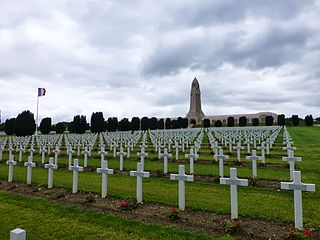
The Douaumont Ossuary is a memorial containing the skeletal remains of soldiers who died on the battlefield during the Battle of Verdun in World War I. It is located in Douaumont-Vaux, France, within the Verdun battlefield, and immediately next to the Fleury-devant-Douaumont National Necropolis. It was built on the initiative of Charles Ginisty, Bishop of Verdun.

The Verdun Memorial is a war memorial to commemorate the Battle of Verdun, fought in 1916 as part of the First World War. It is situated on the battlefield, close to the destroyed village of Fleury-devant-Douaumont in the département of Meuse in north-eastern France.
The 314th Infantry Regiment is an infantry regiment of the U.S. Army first organized in 1917.

The Meuse-Argonne American Cemetery is a 130.5-acre (52.8 ha) World War I cemetery in France. It is located east of the village of Romagne-sous-Montfaucon in Meuse. The cemetery contains the largest number of American military dead in Europe (14,246), most of whom lost their lives during the Meuse-Argonne Offensive and were buried there.
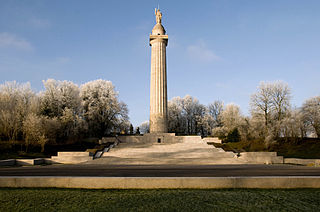
The Meuse-Argonne American Memorial is an American World War I memorial commemorating "the brilliant victory of the American First Army in the Meuse-Argonne offensive, September 26 – November 11, 1918, and pays tribute to the previous heroic services of the Armies of France on the important battle front upon which the memorial has been constructed." It was erected by the United States Government and is the largest of the American war memorials in Europe. Outside Montfaucon in the Meuse department in Grand Est in north-eastern France, it was unveiled on August 1, 1937. The memorial was designed by John Russell Pope. He designed a massive, Doric column in granite. It is surmounted by a statue symbolic of liberty and towers 71 metres (233 ft) above the hill and the war ruins of the village around it.
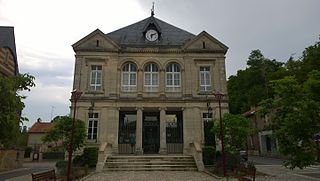
Vienne-le-Château is a commune in the Marne department in north-eastern France.
Nantillois is a commune in the Meuse department in Grand Est in north-eastern France. Nantillois is situated on the D15 between Montfaucon and Romagne-sous-Montfaucon.

Romagne-sous-Montfaucon is a commune in the Meuse department in Grand Est in north-eastern France. The Commune is home to the Romagne '14-'18 museum of WWI artifacts

Vauquois is a commune in the Meuse department in Grand Est in north-eastern France.

William Sawelson was a sergeant in the U.S. Army during World War I. He received the Medal of Honor for valor in combat. The medal was posthumously presented to his father Jacob L. Sawelson at Governors Island.
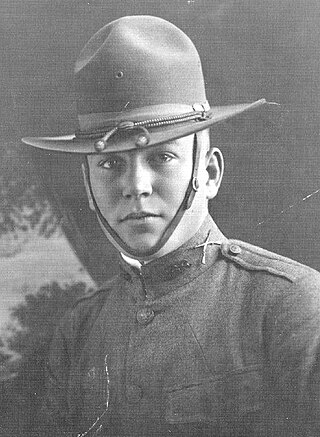
Captain Marcellus Holmes Chiles was a United States Army officer who received the Medal of Honor for his actions during World War I, he suffered wounds that ultimately caused his death during those actions.
The canton of Clermont-en-Argonne is an administrative division of the Meuse department, northeastern France. Its borders were modified at the French canton reorganisation which came into effect in March 2015. Its seat is in Clermont-en-Argonne.










